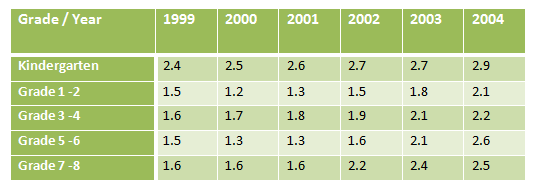» You are advised to spend about a maximum of 20 minutes on this task.
The table below describes percentages of homeschooled students in Some Country in 1999-2004. Write a report for a university lecturer describing the information shown.
» You should write at least 150 words.

Sample Answer 1
The table presents data on the percentages of pupils who got their education at home in a few countries for a span of 5 years, commencing from 1999. As is obvious, the percentages of students who received home education gradually increased except for grade 1 to 4 in 2000.
As can be seen from the given information, about 9% students in some countries went through homeschooling in 1999. Among them, the highest percentage (2.4%) were kindergarten children. All other students who were taught at home from grade 1 to grade 8 were classified in four categories. The ratio of homeschooled children in kindergarten slightly increased in every year and reached to 2.9% in 2004. The ratio of homeschooled pupils from grade 1 to grade 2 was 1.5% in 1999 which was exactly the same as it was for grade 5-6 students. Similarly, 1.6% students, both in grade 3 to 4 and grade 7-8 got homeschooling and this ratio showed an upward trend in 5 years’ time. While almost 1 out of 11 students in 1999 received education at home, this ratio became 1 out of 8 in 2004.
[Written by Shepard]
Sample Answer 2
The presented table gives information about the percentages of students who got home schooling in different academic levels in Some Country from 1999 to 2004. As is seen from the given data, the homeschooling concept became more popular in the later years and highest percentage of homeschooling was done for kindergarten students.
According to the given illustration, 2.4% kindergarten students received home schooling in the year 1999 while this percentage kept on increasing and reached to 2.9% in 2004. Percentage of homeschooling was higher for the kindergarten students than students in other academic levels. In 1999, 1.5% home schooled students could be observed in grade 1-2 & grade 5-6 while this percentage was 1.6% for the remaining two groups (i.e. grade 3-4 & grade 7-8). The percentage of homeschooled students from grade 1-7 showed some fluctuations but these ratios increased over the time. In the year 2004, homeschooled students’ percentage were more than 2% for each category and the highest growth could be observed for the grade 5-6 & grade 7-8 students.
